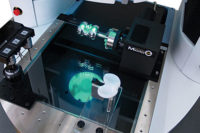Multi-die LED arrays are changing LED strobe lights. A multi-die array LED product can contain 50 to 100 LEDs on a single housing. Using hundreds of small high power LEDs or multi-die LED arrays in a strobe light output, it can outperform existing high output lights including halogen, metal halide and even xenon flash lamp.
Xenon flash lamps have a short duration of active light strobe time. Common flash lamp strobe lamps have duration times of six to 30 microseconds. An LED can be strobed for any duration that is within the safe limit of current as long as heat is managed. The shorter the strobe time, the more power the LED can be over driven producing more light intensity. If an LED light is strobed for a hundred or even hundreds of microseconds, it can produce more intensity than a xenon flash lamp. Even more light intensity is available when the LED is strobed for milliseconds. Since flash lamp bulbs have a very short maximum strobe time, a high power LED light can match and outperform flash lamps using a longer strobe duration than the flash lamp. The advantage is that LEDs can generate light for the entire time an imager acquires the image.
Another setback of the flash lamp is the maximum strobe rate. Common strobe rate is less than 100 Hz or 100 strobes per second (SPS). An advantage of the LED is the extremely fast strobe rate. LEDs can be strobed at high frequencies—hundreds of Hz and even thousands of Hz or SPS. Machine vision LED lights can strobe at rates up to and beyond 5,000 SPS. There is no limit to the maximum strobe frequency of an LED, although rates higher than 5,000 SPS begin to diminish the advantage of over driving. LEDs are a solid state device and have a turn on time in hundreds of nanoseconds, and can be at full power in hundreds of nanoseconds, making them a fast light source. They are perfect for strobing.
LEDs can be strobed for any duration that is within the safe limit of current as long as heat is managed. LEDs can be overdriven or pulsed at high currents for longer durations than flash lamps, and can be overdriven producing up to 10x the normal output vs. running at constant operation. Over driving an LED involves pulsing at very high currents for a short time then allowing a rest time. Low duty cycles allow the LED to produce extreme intensities by pulsing at high currents with low heat. LEDs offer the advantage of controlled light; the strobe time and the intensity can be controlled in an LED light. The strobe time and current to the LEDs can be set, allowing an exact amount of light output. A xenon flash lamp output is set by the size of the bulb and flash time is a constant. Flash lamps are not programmable in the amount of light or duration, whereas an LED light allows the user full control.
Flash lamps use high voltage and discharge energy into the lamp. Because of the high voltage discharge, flash lamps are known to misfire and not produce a flash. LEDs are a semiconductor and driven by low voltage, making them extremely reliable; they are able to run consistently for millions of flashes.
Machine vision cameras have been making steady gains in speed with new cameras reaching 1,000 frames per second (FPS). Faster machine vision cameras are allowing new inspections in applications that were not doable until now. High speed inspections are finding their way into all types of industrial applications, and high speed cameras are making the transition from the scientific world to the machine vision industry.
High speed image acquisition is needed for industrial application including bar code reading for logistics. New conveyors and sorters are moving products and packages at blazing-fast speeds reaching over 800 feet per minute. Keeping pixel blur to a minimum is required for imagers with the reading of 1-D and 2-D bar codes. A logistic system for a large online retailer has conveyor speeds moving at 800 feet per minute. The bar codes need to be read on this line and the megapixel reader system requires two pass reads for system redundancy. This requires that two images or more be acquired and processed before the package can be directed in the sorter. Freezing an image requires a high speed camera and a bright light source. Pixel Blur = (line speed * image exposure time) * (imager size / FOV – Field Of View).
An 800 feet per minute line speed with a two-foot wide conveyor and a three-megapixel camera will need to acquire an image in 73 microseconds to freeze motion with one pixel blur. If the system is acquiring two images then the time is now 36.5 microseconds. An exposure time of 36.5 microseconds requires an intense light source to illuminate the image properly. Imaging systems are currently requiring the light source to produce an adequately illuminated image in 10 to 50 microseconds. The advantage of strobing a large die or multi-die LED light source will be critical in the future for solving high speed applications.
The next generation of LED lights will require the lights to strobe faster with even higher output. Smaller high power LEDs are offering more light in even smaller physical areas. Technology will continue to reduce the size while increasing the power of lights, filling the need for high speed machine vision. Strobed over driven LED lighting is the future for the high speed machine vision industry. V&S
Matt Pinter is a design engineer at Smart Vision Lights. For more information, call (231) 722-1199 or visit www.smartvisionlights.com


